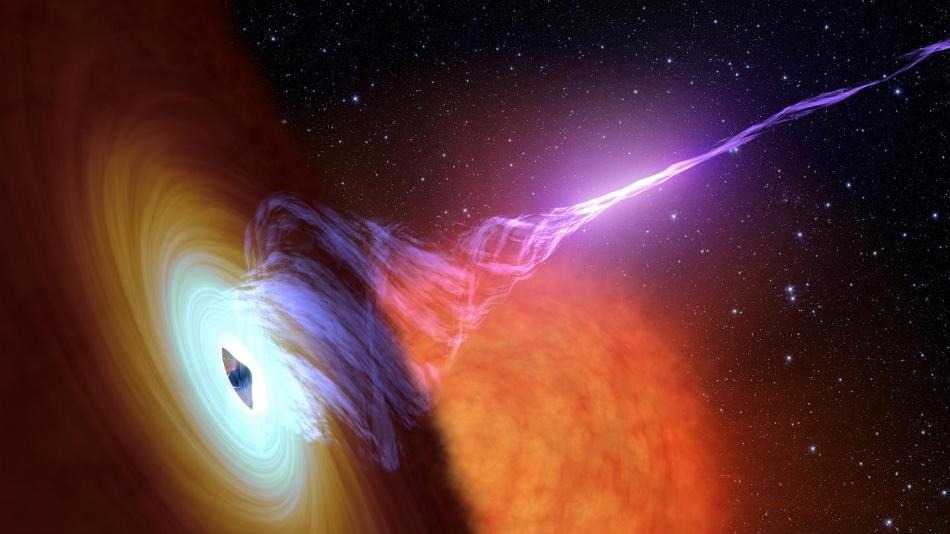Nov 19 2019
The black holes proposed by Einstein’s theory of relativity can be described fully through just three parameters: their mass, electric charge, and spin angular momentum.
 An artist’s conception of a spinning black hole with accretion flow and a jet. Image Credit: NASA/JPL-Caltech.
An artist’s conception of a spinning black hole with accretion flow and a jet. Image Credit: NASA/JPL-Caltech.
As it is impossible to differentiate between two black holes that share these parameters, irrespective of how they were built, it is said that black holes “have no hair”—that is, they have no additional features using which they can be distinguished.
The late Jacob Bekenstein, in the early 1970s, offered evidence for the non-occurrence of hair formed of scalar fields, given a set of hypotheses on the characteristics of the latter. According to researcher Lior Burko from Theiss Research, “Since Bekenstein’s proof, several papers found examples for scalar hair, and all these examples violate one or another of the assumptions made by Bekenstein. But in all cases, the hair was made of the scalar field itself.”
Recently, it was demonstrated that black holes charged by the highest possible electric charge (“extreme black holes”) can possess one more property, permanent hair composed of a massless scalar field, and that this newly discovered hair can be seen from a great distance.
A massless scalar hair does not violate any of the assumptions underlying Bekenstein’s proof. It was a big surprise for me when this new hair was found by Angelopoulos, Aretakis, and Gajic, so I wanted to look at it in greater detail. It is hair in a different sense than the kinds of hair that were found before.
Lior Burko, Researcher, Theiss Research
Burko continued, “It is not the scalar field itself, but a certain integral on a derivative of the scalar field that is to be calculated on the surface of the black hole, on its event horizon.”
Through the calculation of a different quantity there, it would be possible to observe the new hair from a considerable distance.
“The measurement at a great distance that Angelopoulos, Aretakis, and Gajic found is strictly speaking precise only at infinitely late time. These would be observers who are very distant from the black hole, and who make the measurements in the infinite future,” noted Burko.
We wanted to see what happens at late but finite times, to see the time dependence of the measurement and how it approaches its asymptotic value. Another special thing about this new hair is that it is applies only for exactly extreme black holes, and we wanted to understand what happens when the black hole is nearly extreme, but not exactly extreme.
Lior Burko, Researcher, Theiss Research
In a paper published recently in Physical Review Research, Burko and his collaborators—Gaurav Khanna from the University of Massachusetts Dartmouth and his former student Subir Sabharwal, who is with the Eastamore Group at present—demonstrated that measurements from a great distance are reaching the hair value, where the difference between them is decaying with inverse time.
However, they took a step forward than the original model employed by Angelopoulos, Aretakis, and Gajic, generalizing the hair to black holes that rotate at the highest possible spin rate or very close to it.
“In addition to a maximal value of charge, there is also a limit for how fast a black hole can spin. Black holes that spin at the maximal allowed rate are therefore also called extreme black holes. We describe both maximally charged and maximally spinning black holes by the name extreme black holes, as there are many similarities between the two,” added Burko.
The new hair was originally found for a very useful toy model for black holes, specifically black holes that are spherically symmetric and electrically charged. But black holes in reality are neither. Instead, we wanted to find out if this hair can be found also for spinning black holes. In the movie Interstellar the monster black hole is nearly extreme. We wanted to see if Gargantua has hair.
Lior Burko, Researcher, Theiss Research
The researchers used highly intensive numerical simulations to arrive at their results. As part of the simulations, dozens of the most sophisticated Nvidia graphics-processing-units (GPUs), each including more than 5,000 cores, were used in parallel. “Each of these GPUs can perform as many as 7 trillion calculations per second; however, even with such computational capacity the simulations took many weeks to complete” stated Khanna.
The researchers demonstrated that for the almost extreme spinning black holes, the hair is a transient behavior. At intermediate times, the behavior of the almost extreme black holes is similar to that of extreme black holes. However, at late times, their behavior is similar to that of regular, non-extreme black holes.
“Nearly extreme black holes can pretend that they are extreme for only so long. But eventually their non-extremality becomes manifest,” concluded Burko. “Nearly extreme black holes that attempt to regrow hair will lose it and become bald again.”
In addition, the researchers debated the observational features, for instance, with observatories of gravitational waves like LISA or LIGO/VIRGO, of the smoking-gun detection of almost extreme black holes.
The study was partly supported by the National Science Foundation and the Office of Naval Research. As part of the study, computational resources of UMass Dartmouth’s Center for Scientific Computing & Visualization Research (CSCVR) were utilized.